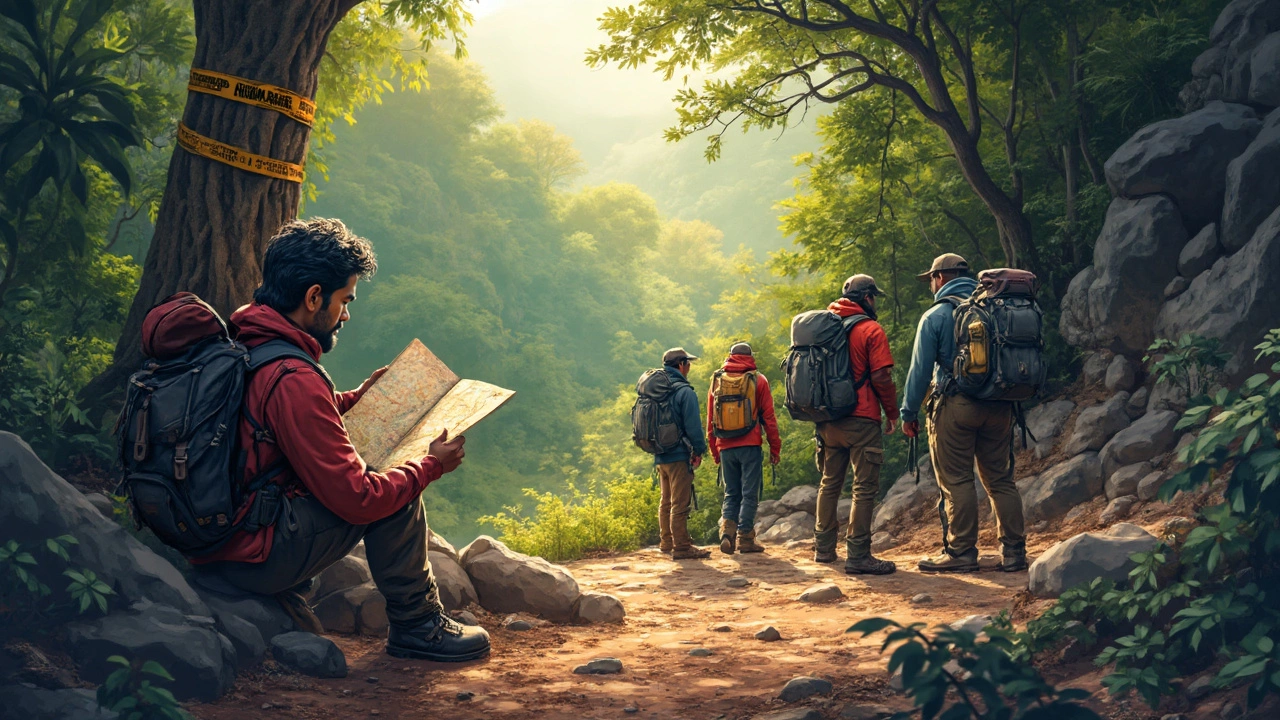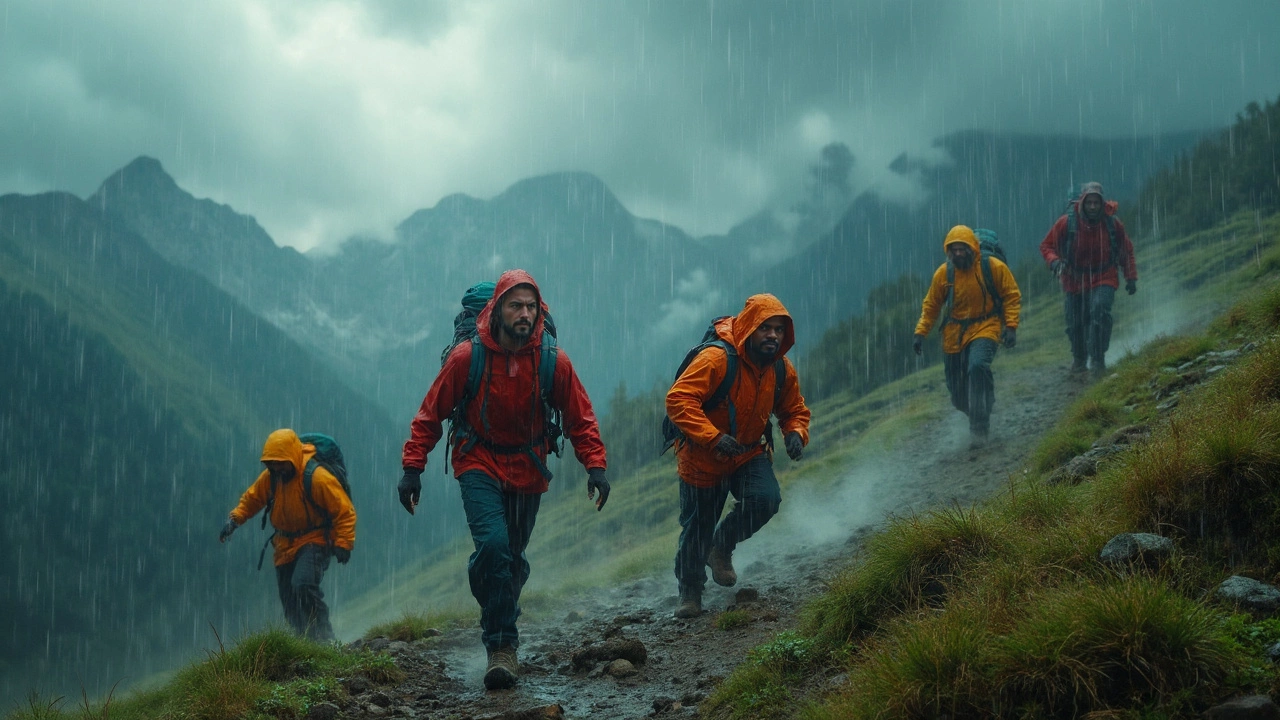There’s no shortage of epic trekking spots in India, but before you lace up your boots, there’s one question every hiker should ask: 'What’s the worst situation I could stumble into out there?' Getting caught in the wrong scenario can wreck more than just your adventure—it could actually put you in real danger.
First thing: weather in India’s hiking zones can flip in minutes. Ever seen the clouds in Himachal or the Western Ghats during monsoon? You could set off in sunshine and run straight into a whiteout or a downpour strong enough to turn a trail into a river. It only takes one slide of mud or shift of fog to mess up your orientation or footing.
But it’s not just about the skies. Certain trails lure hikers with amazing photos online, but leave out serious hazards—crumbly cliff edges, loose rocks, or alpine sections that need ropes and gear. You gotta know which spots get sketchy, especially if you’re going solo or without guides.
- Treacherous Weather Traps
- Risky Routes and Sketchy Terrain
- Wildlife Encounters Gone Wrong
- Planning Pitfalls to Watch Out For
Treacherous Weather Traps
India’s hiking regions can turn wild real quick. The most popular trails—from Kedarkantha up north to Kudremukh down south—all have legendary weather swings. One morning you’re walking under a clear blue sky, and by afternoon, you’re dodging soaking rain, gusts of wind, or even hail. The Himalayas are especially notorious: most accidents above 3,000 meters have some weather link, according to the Indian Mountaineering Foundation.
Monsoon hiking in the Western Ghats or Nilgiris? That’s another beast. Landslides block paths, rivers rise, and leeches swarm just about everywhere. Flash floods can happen out of nowhere, and some routes straight-up disappear underwater. Check this out:
| Region | Dangerous Weather | Common Months |
|---|---|---|
| Himachal Pradesh | Sudden snowstorms, fog | Oct-April |
| Western Ghats | Heavy rain, landslides | June-September |
| Uttarakhand | Flash floods, hail | July-September |
| Ladakh | High altitude wind, snow | All year (esp. winter) |
Most local guides say you should always check not just the forecast, but also ask villagers or forest rangers what the weather’s done in the last few days. As Bhupendra Rana, a trek leader from Uttarakhand, told me,
“You can’t trust your phone’s weather app in the mountains. I’ve seen groups stranded just because the forecast was wrong by a few hours.”
Here’s how not to get caught by one of these traps:
- Pile warm layers and rain gear into your pack—always, even if it looks clear.
- Start early in the day. Afternoon storms are almost a routine in places like Himachal and Sikkim.
- Never cross big rivers during or right after storms. Water can rise waist-high in minutes.
- If the clouds look mean or the wind picks up, find cover in a safe spot instead of pushing ahead.
If there’s one thing every trekker learns, it’s that hiking safety on Indian trails is all about reading the sky and listening to locals. Missing this step? That’s the kind of mistake you won’t forget.
Risky Routes and Sketchy Terrain
Some trekking trails in India offer jaw-dropping views, but that comes at a price. The terrain on these trails can get brutal fast, especially if you’re not ready. The most important thing? Recognizing spots where the trail is more trouble than it’s worth. You’ll find these obstacles everywhere from Uttarakhand’s Valley of Flowers to the tricky slopes near Roopkund and the muddy, root-covered paths in the Western Ghats.
Here’s the problem with sketchy routes: a lot of them aren’t marked well. Sometimes trail markers vanish after a landslide or monsoon season just wipes them out. You might be following a path that, on your map, looks totally normal—until you hit a crumbling edge or a patch where the rocks give way with one wrong step.
Certain spots are notorious for accidents, usually because hikers underestimate the risks. Chadar Trek over the frozen Zanskar River? It looks epic on Instagram but thin ice takes down dozens every season. Added stat: India’s National Disaster Management Authority reported that almost 40% of high-altitude rescue operations in 2024 were triggered by folks on unstable or tricky stretches of trail.
| Famous Indian Trek | Known Hazards |
|---|---|
| Roopkund | Landslides, loose rocks, altitude sickness |
| Valley of Flowers | Muddy slopes, slippery bridges, sudden weather changes |
| Chadar Trek | Thin/fresh ice, unpredictable cracks, fast currents underneath |
| Kumara Parvatha | Unmarked trails, steep ascents, leeches in monsoon |
Here’s how to keep out of trouble on sketchy terrain:
- Ask locals, guides, or forest officials about the trail conditions before you set out. Old info from blogs doesn’t cut it—things change, especially after storms or landslides.
- Pace yourself. Going too fast on poor terrain is the best way to twist an ankle or send loose rocks tumbling.
- If the route gets iffy—like ice cracking, rocks sliding, or paths disappearing—turn back. There’s no shame in bailing if the alternative is a rescue call.
- Carry trekking poles. They help on slippery slopes and uneven surfaces, and can double as a probe for thin ice or mud.
Anyone planning a longer trek should bring a paper map or download an offline GPS trail map. Don’t trust battery-powered devices alone in the backcountry. The best trekkers always have backup plans and know the easy exits if things get hairy.

Wildlife Encounters Gone Wrong
Out on Indian trails, stumbling into the wrong kind of wildlife is a real risk—not just an adventure story for later. Tigers and leopards are at the top of most folks’ worry list, but the truth is, elephants, snakes, and even monkeys cause more problems for hikers. Jim Corbett National Park, for example, is famous for tiger sightings, but it’s actually wild elephants that most often block trails and turn treks dangerous.
The Forest Survey of India noted a spike in elephant encounters between 2023 and 2024, especially during early mornings and late evenings on popular trekking routes in the Western Ghats. Elephants move in herds and can get aggressive fast if they sense people coming close to their young. Never try to sneak past or take photos up close—most accidents happen when hikers get too bold. As one seasoned wildlife biologist put it,
"Hiking isn’t about proving bravery. It’s about making it out safe. Give wildlife the space they deserve; they don’t know you’re just passing through."
Now, let’s talk snakes. India is home to some of the world’s most venomous snakes—like the Russell’s viper and the Indian cobra. They love hiding along shaded trails or sunny rock patches. Most bites happen when someone steps on or disturbs them by accident. Don’t reach blindly into dense bushes or under rocks. If you spot a snake, stop right there and slowly back away. Never try to move or poke it out with a stick.
Monkeys are another headache. In the lower Himalayas, especially around places like Rishikesh or Dharamshala, macaques have learned hikers carry snacks. They’re bold, sometimes yanking bags or shiny objects straight from your hands. Best defense? Don’t eat openly on the trail, keep food zipped up, and never feed wildlife if you want a peaceful trip.
- Stay alert for animal tracks and droppings—they usually warn of wildlife nearby.
- Hike in groups where possible; animals are less likely to mess with big crowds.
- Make noise at bends, especially in dense forests, so nothing gets startled.
- Get the latest info from local forest rangers about recent animal sightings before heading out.
Bottom line: hiking in India’s wild zones isn’t just about epic views. Respect the animals, stay aware, and remember, avoiding a dangerous scene is way cooler than any selfie with a wild creature. Safe trekking beats a wild chase every time.
Planning Pitfalls to Watch Out For
Planning makes or breaks any trek, especially in India where local conditions are unpredictable. Loads of hikers get caught off guard not because the mountains are tricky, but because their prep is sketchy. Want to stay on the safe side? Don’t gamble with your route, your gear, or your basic information.
Let’s start with research. People often trust random blogs or Instagram posts instead of real trip reports or local guides. That’s a shortcut to being stuck on a washed-out route. For instance, some spots marked ‘easy’ online can turn wild with landslides by mid-June—Roopkund and Valley of Flowers are classic examples. Always check the latest reports from verified sources.
- Trekking India demands permits for many places like Kedarkantha, Sandakphu, and even some forest patches in Western Ghats. Showing up without one can ruin your plans or even get you fined. Some parks also cap the daily number of trekkers.
- Packing right is non-negotiable. Temperatures on some Himalayan trails drop to -10°C at night, so a cheap sleeping bag or jacket will get you into trouble quick. Cross-verify packing lists with experienced trekkers or local guides before you head out.
- Pay attention to group size. Most experienced hikers recommend groups of at least three, so if you get hurt, someone can stay while another goes for help. Solo hikes in heavy monsoon or extreme altitude can go south fast.
"Even seasoned trekkers make mistakes. The most common one is underestimating the weather or terrain just because a blog said it’s ‘beginner friendly.’" — Puneet Dutt, Trek Leader at Indiahikes
It helps to check stats and trends before setting out. For instance:
| Region | Main Planning Risk | Peak Accident Months |
|---|---|---|
| Uttarakhand | Lack of permits, landslides | June, September |
| Sikkim | Poor phone signal, sudden weather shifts | May, October |
| Western Ghats | Flash floods, wrong route info | July, August |
One more thing: share your itinerary with someone who isn’t going. If you drop off the grid, at least someone knows where you’re supposed to be.
The bottom line? Overplanning is better than winging it. Most close calls and rescues in Indian trekking spots can be traced back to overlooked details or straight-up guesswork. Do your homework, stay smart, and you’ll dodge most disasters before you even hit the trail.
